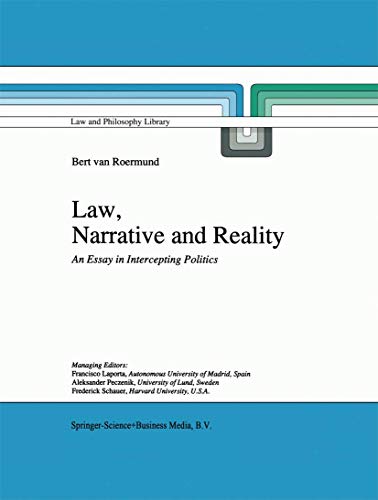Law, Narrative and Reality: An Essay In Intercepting Politics (Law And Philosophy Library): 30 - Softcover
Buch 49 von 106: Law and Philosophy Library
Inhaltsangabe
This book is at odds with the presuppositions behind a received view on law as a systematic solution to social problems in the name of justice. It argues that neither do facts in law represent social reality, nor do norms represent a moral ideal. Representationalism as such, in its various legal guises, is put to the test of what is called here `the interception hypothesis'. Although it is derived from the theory of literature (the theory of narrative) and corroborated by several close reading analyses of legal texts (both decisions and statutory rules), this hypothesis aims, in the first part, at providing an alternative model for the structure and the value of legal knowledge. The second part shows how this knowledge is operative in fundamental concepts like democracy, punishment and (contractual) obligation.
Die Inhaltsangabe kann sich auf eine andere Ausgabe dieses Titels beziehen.
Reseña del editor
To a certain extent, this book is a translation of Recht, verhaal en werke lijkheid, published by Coutinho (Bussum, 1993). Chapters 1, 5 and 9, however, differ considerably from the original. At the basis of the Dutch book were arguments already submitted in 'Narrative coherence in legal contexts', in C. Faralli and E. Pattaro (eds.), Reason in Law, vol. III., Milano, A. Giuffre Editore, 1988, pp. 159-170; 'Justice, Rights, and Hu man Dignity', in The Windsor Yearbook of Access to Justice, 7, 1987, pp. 46-65; 'Narrative coherence and the guises of legalism', in P. Nerhot (ed.), Law, Interpretation and Reality, Dordrecht - Boston, Kluwer Aca demic Publishers, 1990, pp. 310-345; 'The Instituting of Brute Facts', in The International Journal for the Semiotics of Law / Revue internationale de semiotique juridique, 4, 1991, pp. 279-308. For chapters 1 and 9 I used the following materials: 'Law is narrative, not literature', in W.l. Witte veen (ed.), Law, Rhetoric and Literature (Special Issue of the Dutch Jour nal for Legal Philosophy and Legal Theory), 23, No.3, 1994, Zwolle, Tjeenk Willink, 1994, pp. 221-227 (with a response by R. Weisberg, pp. 228-229); and 'Seeing Places: On Prepositions in Law', The International Journal for the Semiotics of Law / Revue internationale de semiotique juridique, 6, 1993, pp. 249-270. Chapter 5 was rewritten on the basis of 'The Instituting of Brute Facts'.
Reseña del editor
This book is at odds with the presuppositions behind a received view on law as a systematic solution to social problems in the name of justice. It argues that neither do facts in law represent social reality, nor do norms represent a moral ideal. Representationalism as such, in its various legal guises, is put to the test of what is called here `the interception hypothesis'. Although it is derived from the theory of literature (the theory of narrative) and corroborated by several close reading analyses of legal texts (both decisions and statutory rules), this hypothesis aims, in the first part, at providing an alternative model for the structure and the value of legal knowledge. The second part shows how this knowledge is operative in fundamental concepts like democracy, punishment and (contractual) obligation.
„Über diesen Titel“ kann sich auf eine andere Ausgabe dieses Titels beziehen.
Weitere beliebte Ausgaben desselben Titels
Suchergebnisse für Law, Narrative and Reality: An Essay In Intercepting...
Law, Narrative and Reality | An Essay in Intercepting Politics
Anbieter: preigu, Osnabrück, Deutschland
Taschenbuch. Zustand: Neu. Law, Narrative and Reality | An Essay in Intercepting Politics | G. C. van Roermund | Taschenbuch | ix | Englisch | 2010 | Springer | EAN 9789048148714 | Verantwortliche Person für die EU: Springer Verlag GmbH, Tiergartenstr. 17, 69121 Heidelberg, juergen[dot]hartmann[at]springer[dot]com | Anbieter: preigu. Artikel-Nr. 107119779
Neu kaufen
Anzahl: 5 verfügbar
Law, Narrative and Reality: An Essay in Intercepting Politics (Law and Philosophy Library)
Anbieter: Revaluation Books, Exeter, Vereinigtes Königreich
Paperback. Zustand: Brand New. 240 pages. 9.00x6.00x0.57 inches. In Stock. Artikel-Nr. x-9048148715
Neu kaufen
Anzahl: 2 verfügbar
Law, Narrative and Reality : An Essay in Intercepting Politics
Anbieter: AHA-BUCH GmbH, Einbeck, Deutschland
Taschenbuch. Zustand: Neu. Druck auf Anfrage Neuware - Printed after ordering - To a certain extent, this book is a translation of Recht, verhaal en werke lijkheid, published by Coutinho (Bussum, 1993). Chapters 1, 5 and 9, however, differ considerably from the original. At the basis of the Dutch book were arguments already submitted in 'Narrative coherence in legal contexts', in C. Faralli and E. Pattaro (eds.), Reason in Law, vol. III., Milano, A. Giuffre Editore, 1988, pp. 159-170; 'Justice, Rights, and Hu man Dignity', in The Windsor Yearbook of Access to Justice, 7, 1987, pp. 46-65; 'Narrative coherence and the guises of legalism', in P. Nerhot (ed.), Law, Interpretation and Reality, Dordrecht - Boston, Kluwer Aca demic Publishers, 1990, pp. 310-345; 'The Instituting of Brute Facts', in The International Journal for the Semiotics of Law / Revue internationale de semiotique juridique, 4, 1991, pp. 279-308. For chapters 1 and 9 I used the following materials: 'Law is narrative, not literature', in W.l. Witte veen (ed.), Law, Rhetoric and Literature (Special Issue of the Dutch Jour nal for Legal Philosophy and Legal Theory), 23, No.3, 1994, Zwolle, Tjeenk Willink, 1994, pp. 221-227 (with a response by R. Weisberg, pp. 228-229); and 'Seeing Places: On Prepositions in Law', The International Journal for the Semiotics of Law / Revue internationale de semiotique juridique, 6, 1993, pp. 249-270. Chapter 5 was rewritten on the basis of 'The Instituting of Brute Facts'. Artikel-Nr. 9789048148714
Neu kaufen
Anzahl: 1 verfügbar

